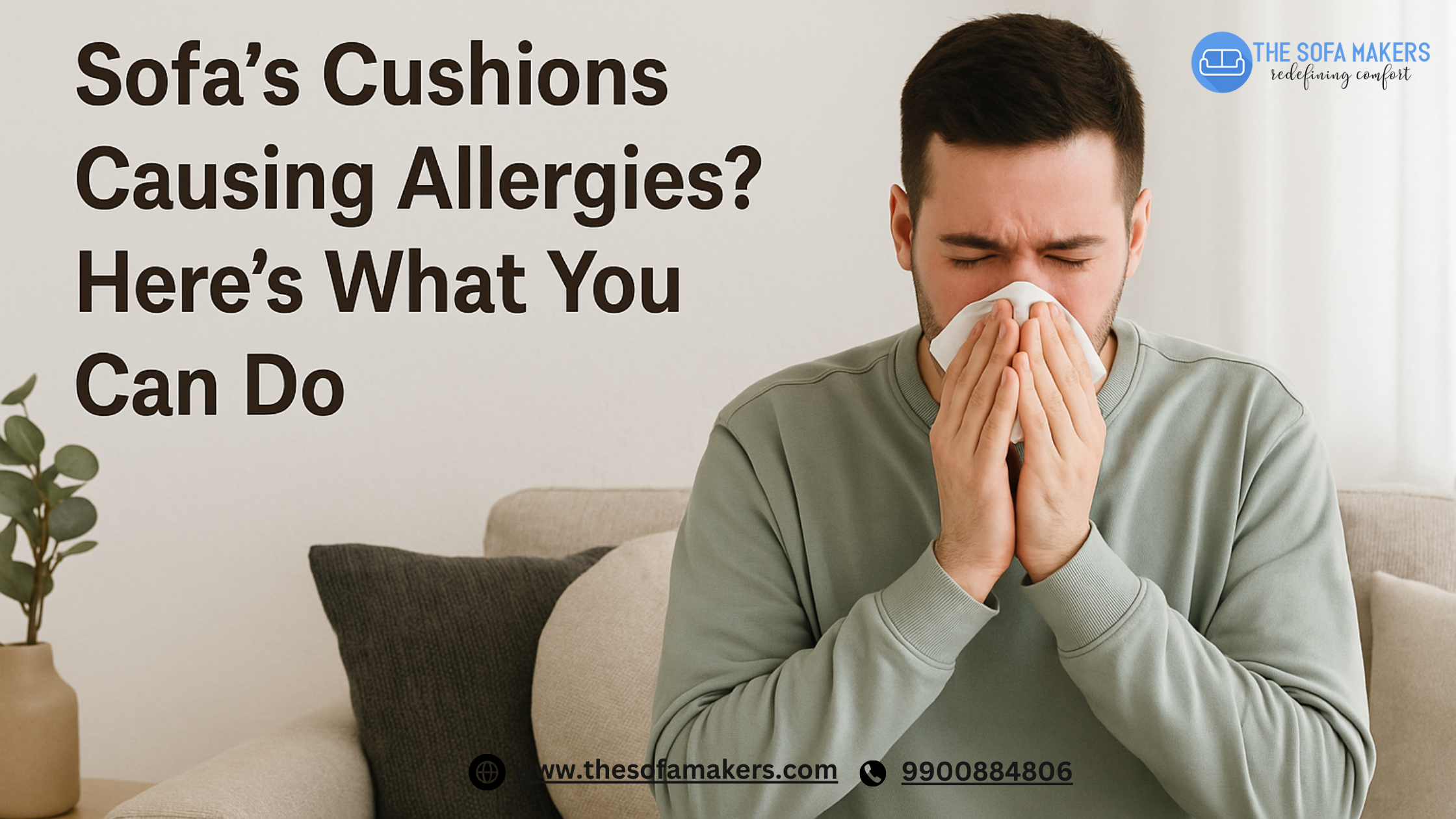Sofa’s Cushions Causing Allergies? Here’s What You Can Do

Have you ever noticed sneezing, itching, or watery eyes after lounging on your sofa? You’re not alone. Many homeowners suffer from allergy symptoms without realizing their sofa cushions may be the root cause. Over time, even the most luxurious couches can become hidden havens for dust mites, allergens, mold, and bacteria.
At The Sofa Makers, Bangalore, we’ve helped hundreds of customers find relief through professional cushion replacement, sofa fabric change, and recliner upholstery services. In this article, we’ll explore why your sofa cushions may be triggering allergies—and most importantly, what you can do to fix it.
How Sofa Cushions Become Allergen Magnets
Your sofa is one of the most used furniture pieces in your home. It’s where family, pets, and guests gather, which makes it a hotspot for collecting allergens. Here’s what typically happens inside your sofa cushions over time:
1. Dust Mites
These microscopic creatures thrive in warm, humid environments and feed on dead skin cells. Old sofa cushions, especially those with fabric covers and foam interiors, provide the perfect breeding ground.
2. Pet Dander and Hair
If you have pets, their dander and hair settle into cushion fabrics and foam. Even regular vacuuming may not reach deep enough to remove it completely.
3. Mold and Mildew
In Bangalore’s humid climate, foam can absorb moisture, leading to the growth of mold and mildew inside your cushions. This can cause respiratory irritation and musty odors.
4. Pollen and Pollutants
When you leave windows open or come in from outdoors, airborne particles like pollen, smoke, and pollutants settle into soft surfaces—including your sofa cushions.
Signs Your Sofa Cushions Might Be the Cause of Your Allergies
Wondering whether your sofa is to blame? Here are some red flags to watch for:
- Sneezing, coughing, or runny nose after sitting on the couch
- Itchy eyes or skin irritation during or after use
- Musty or unpleasant odor from the cushions
- Visible stains, dust, or discoloration on fabric
- Increased allergy symptoms indoors compared to outdoors
If you notice any of these symptoms, it’s time to consider cushion replacement or sofa fabric change.
What You Can Do: Healthier Sofa Solutions
Now that you know your sofa could be triggering allergies, here’s how you can tackle the issue effectively—with help from The Sofa Makers, Bangalore.
1. Replace Old Sofa Cushions
Old cushions often harbor allergens deep inside the foam that can’t be removed with cleaning alone. Cushion replacement is the most effective way to eliminate these triggers.
At The Sofa Makers, we offer:
- High-resilience, hypoallergenic foams
- Memory foam options for extra comfort
- Custom thickness and density tailored to your needs
New cushions not only improve your comfort—they support a healthier living space.
2. Choose Hypoallergenic Upholstery Fabrics
The fabric you choose matters just as much as the foam inside. Traditional upholstery materials like cotton or velvet tend to trap dust and allergens.
Instead, we recommend:
- Microfiber and leatherette (dust-repellent and easy to clean)
- Anti-microbial, water-resistant fabrics
- Allergy-safe covers with tight weaves
With a professional sofa fabric change, you can drastically reduce allergen buildup and make cleaning easier.
3. Go for Recliner Repair and Upholstery If Needed
Recliners are often overlooked in allergy-proofing, but they can collect just as much dust and dander, especially around the seams and mechanisms.
Our recliner repair and recliner upholstery services can:
- Replace old, worn foam and fabric
- Install hypoallergenic cushioning and breathable material
- Fix creaky, hard-to-clean areas around reclining mechanisms
This not only restores your recliner’s comfort but makes it allergy-safe too.
4. Schedule Regular Maintenance
Even with new cushions and fabric, regular care is essential. Here’s what we recommend:
- Vacuum weekly with a HEPA filter vacuum
- Use fabric protectors that repel moisture and dust
- Sun-dry removable covers once a month to prevent mold
- Professional cleaning every 6–12 months
At The Sofa Makers, we also offer annual sofa health checks—where we assess foam integrity, fabric hygiene, and recommend solutions.
5. Add Zippered Protective Covers
For an extra layer of protection, ask us to install zippered, removable covers during your cushion or fabric replacement. These covers are washable and act as a barrier against allergens.
Bonus: You can rotate them based on seasons or décor changes!
Allergies can make daily life uncomfortable—but your sofa doesn’t have to be part of the problem. With professional cushion replacement, sofa fabric change, and recliner upholstery, you can turn your living room into a healthier, more inviting space.
Don’t wait for symptoms to get worse. Take the first step toward an allergy-free home with The Sofa Makers, Bangalore.
0 Comments